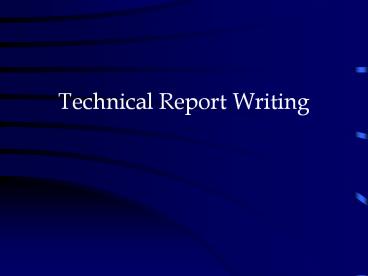Technical Report Writing - PowerPoint PPT Presentation
Title:
Technical Report Writing
Description:
Technical Report Writing. * * * * * * * Technical writing Journal paper Thesis Dissertation Report Elements of a Technical Report Title Abstract (Executive Summary ... – PowerPoint PPT presentation
Number of Views:219
Avg rating:3.0/5.0
Title: Technical Report Writing
1
Technical Report Writing
.
2
Technical writing
- Journal paper
- Thesis
- Dissertation
- Report
3
Elements of a Technical Report
- Title
- Abstract (Executive Summary)
- Introduction
- Theory and Analysis
- Experimental Procedures
- Results and Discussion
- Conclusion(s)
- Acknowledgments
- References
- Appendix
4
Writing Style
- Depends on the audience
- More Lively Writing (usually preferred)
- First Person, Active Voice, Past/Present Tense
- More Formal Writing
- Third Person, Passive Voice, Past/Present Tense
- Never use slang
5
Writing Style
- Use First-Person, Active Voice, Past Tense or
Third-Person, Passive Voice, Past Tense - Not Recommended Clean the gallium arsenide
substrates by boiling them in trichloroethylene. - Not Recommended I clean the gallium arsenide
substrates by boiling them in trichloroethylene. - Acceptable The gallium arsenide substrates were
cleaned by boiling in trichloroethylene. - Recommended We cleaned the gallium arsenide
substrates by boiling them in trichloroethylene.
6
Writing Mechanics
- Check Spelling
- Check Grammar
- Minimize the use of Acronyms
- If Acronyms are necessary, always define them at
the first use - Number all equations, tables, and figures
- All tables and figures must have captions.
- All figures must have labeled axes
- All quantities must have units
7
Writing the Report An Approach
- Decide on a title
- Create a brief outline with only main section
headings - Create a more detailed outline with subheadings
- Create an executive summary
- Create the main body of text
- Insert tables, figures, references, and
acknowledgements
8
Abstract or Executive Summary
- Think of it as a substitute for the report for a
busy reader - Length never less than three sentences or longer
than a full page. Often 200 words. - Sentence One expand on the title
- Sentence Two why the work was done
- Remainder key results, with numbers as
appropriate, conclusions, recommendations
9
Introduction
- This is not a substitute for the report, and so
does not echo the abstract - Here is the place for context, relation to prior
work, general objective, and approach
10
Theory and Analysis
- Briefly describe the theory relevant to the work
- Provide design equations
- Include calculations and computer simulation
results - Provide values for all key parameters
11
Experimental Procedures
- Describe Apparatus and Materials
- Show test setups
- If this section is well written, any electrical
or computer engineer should be able to duplicate
your results.
12
Results and Discussion
- Use tables and graphs
- Consider moving large quantities of raw data,
detailed derivations, or code to an appendix - Methods of plotting which produce well delineated
lines should be considered - Results should be critically compared to theory
- Consider limitations in the theory and
engineering tolerances
13
Conclusion
- Similar to executive summary
- Must be concise
- Reinforces key ideas formed in discussion
- Includes recommendations for future work, such as
implementation of a design
14
Figures and Tables
- Every figure must have a caption
- All tables must have a title
- Figure/tables are placed after they are mentioned
in the text (all must be mentioned/discussed) - Make figures/tables first, and then insert into
the text - Put the figure/table number beside its title, and
put this in a standard location - Dont start a sentence with an abbreviation
Figure vs. Fig.
15
Acknowledgements
- Keep track of those to be acknowledged-keep a
diary so that you dont forget anyone - Include your sponsor, outside sources (companies
or agencies), other departments on campus,
individuals outside of your team who have helped - Be brief
16
References
- Various formats have been developed. Pick one
you like such as the IEEE Transactions format - Decide on a sequence, such as the order they
appear in the text - Always give full references such that others may
find the item
17
References (examples)
- 1 A. Student and B. Professor, Very Important
Project, in Journal of Irreproducable Research,
vol. 13, no. 9, pp. 25-31, Nov. 2004. - 2 C. Dean, The Book of Earth-Shattering
Research, Husky Press, Storrs, CT, 2005.
18
Plagiarism
- Never take the work of others without giving
proper credit - Never take verbatim sentences/paragraphs from the
literature - If you feel that you must use verbatim material,
use quotation marks and a reference. Do this
sparingly! - There are search engines that can find if
verbatim material has been stolen. Professors
fail students who do this. Additional
disciplinary action may follow.
19
References
- William Strunk and E. B. White, The Elements of
Style (New York Macmillian, 2000). - H. R. Fowler, The Little, Brown Handbook
(Boston Little, Brown and Company, 1980). - G. L. Tuve and L. C. Domholdt, Engineering
Experimentation (New York McGraw-Hill Book Co.,
1966). - Craig Waddell, Basic Prose Style and Mechanics
(Troy, NY Rensselaer Press, 1990). - Joseph Williams, Style Ten Lessons in Clarity
and Grace (Glenview, IL Scott, Foresman, 1981). - ECE Dept, Engineering Report Writing, September
2003.































